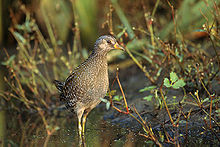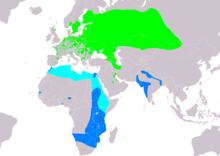Spotted Moorhen
| Spotted Moorhen | ||||||||||||
|---|---|---|---|---|---|---|---|---|---|---|---|---|

Spotted Moorhen ( Porzana porzana ) |
||||||||||||
| Systematics | ||||||||||||
|
||||||||||||
| Scientific name | ||||||||||||
| Porzana porzana | ||||||||||||
| ( Linnaeus , 1766) |
The spotted moorhen ( Porzana porzana ) is a member of the common railing family . It is smaller than a water rail and about the size of a thrush .
Appearance
Spotted Moorhen have a body length of about 19 to 22.5 centimeters. The easiest way to distinguish them from water rails is their short, straight beak. This is yellow with a red base. Adult birds have a predominantly brown underside with a blue-gray chest. You can see pale yellow stripes on the flanks. Feathers on the back and the feather blankets in the middle are black. The body plumage on the top also has many small white spots. The legs of adult birds are greenish in color and have large toes typical of railings.
Young birds that are not yet fully grown are similar to adults; with them, however, the breast plumage is still brown.
Habitat and distribution area
The distribution area of the spotted marsh grouse extends from west and south-west Europe to the south of central Siberia. There are individual occurrences in Spain, Italy and Greece. Furthermore, a closed distribution area extends from the Crimea to the Caucasus. There are also individual areas of distribution in Central Asia.
The spotted moorhen breeds in swamp areas, fens and sedge stocks from Europe to Central Siberia . The nests are created in dry locations within this habitat and are well hidden. Mostly they are located close to the ground or in a sedge hut. Nests occasionally have a roof made of leaves. Between April and June the females lay around eight to 12 eggs with a yellowish base color, which also have small reddish-brown spots. The chicks initially have a black down dress and are able to fly after about 35 to 42 days.
The wintering areas are in Africa and India.
food
The spotted moorhens look for food with their beaks in the mud or in shallow waters. This consists mainly of small animals such as insects, worms and snails. They also consume delicate parts of plants.
Endangerment & Protection Status
The spotted moorhen is considered "endangered" in Germany (Red List Cat. 3). It is a species of Appendix I of the EU Bird Protection Directive (RL 79/409 / EEC).
The population in Europe is estimated at 120,000 to 260,000 breeding pairs. Countries with more than 20,000 breeding pairs are Russia, Belarus and Ukraine. More than 2,000 breeding pairs are found in Estonia, Poland and Romania. In Central Europe the species occurs in all countries, but Poland is clearly the main area of distribution with a breeding pair population of 2,500 to 3,500. At the beginning of the 21st century, the entire breeding bird population in Central Europe was between 4,000 and 6,000 breeding pairs, of which approx. 1,000 to 1,500 breeding birds were in Germany.
The spotted moorhen is one of the species for which a significant shift in area is suspected as a result of climate change. A research team that, on behalf of the British environmental authority and the RSPB, examined the future development of the distribution of birds on the basis of climate models, assumes that large parts of the current range will no longer offer suitable habitats for the potted marsh. Based on these forecasts, the distribution area would shift significantly to the northeast.
supporting documents
literature
- Hans-Günther Bauer, Einhard Bezzel , Wolfgang Fiedler (eds.): The compendium of birds in Central Europe: Everything about biology, endangerment and protection. Volume 1: Nonpasseriformes - non-sparrow birds. Aula-Verlag Wiebelsheim, Wiesbaden 2005, ISBN 3-89104-647-2 .
Web links
- Porzana porzana in the endangered Red List species the IUCN 2008. Posted by: BirdLife International, 2008. Accessed January 31 of 2009.
- Videos, photos and sound recordings about Porzana porzana in the Internet Bird Collection
- Spotted Moorhen's feathers
Single receipts
- ↑ a b Christoph Grüneberg, Hans-Günther Bauer, Heiko Haupt, Ommo Hüppop, Torsten Ryslavy & Peter Südbeck: Red List of Germany's Breeding Birds , 5th version, November 30, 2015 . In: Reports on bird protection . tape 52 , 2015, p. 19-67 .
- ↑ Bauer et al., P. 396.
- ^ Brian Huntley, Rhys E. Green, Yvonne C. Collingham, Stephen G. Willis: A Climatic Atlas of European Breeding Birds , Durham University, The RSPB and Lynx Editions, Barcelona 2007, ISBN 978-84-96553-14-9 , P. 77.



